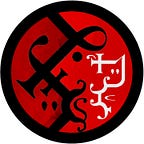Minauros Principality — Intro
Minauros has been the poorest principality of the Holy Infernal Empire for centuries: a vast part of the territory is occupied by the Flesh Fields, a disgusting landscape made of parts of bodies of different sizes all meld together. This Shard of the Beyond was only seen as an unexploitable wasteland, and the inhabitants often emigrated to other nations looking for work. Every job was considered better than living in the miasma-ridden flesh-scape, so the minaurian accepted the most menial occupations, becoming a synonym for the derelict and desperate.
Things changed in the last fifty years or so: new advancements in magic science made it possible to improve living conditions and to turn the source of their problem into assets. Fat, leather, and other goods are harvested, worked, and traded so that now Minaurians are despised for being crass new rich instead of poor laborers.
People don’t live in the middle of the Flesh Fields, and the first reason is that there is no solid ground. The land is made of human flesh covered in a continuous layer of skin. Body parts are meshed together without logic and can be of vastly different sizes: a hill may be just one gigantic tight with at its base a grassland of small fingers; a stretch of thoraxes may be interrupted by a giant mouth, hard to pass as a crevasse; a huge ear may lead to a long and convoluted cave made of different organic tunnel. Nothing stays still: the muscles underneath the skin twitch and cramp, and limbs and organs have an aimless functionality. There are no plants here: patches of hair may look like bushes or grass, an area affected by mycosis may look like a small garden, and some bones extrusion looks like trees.
Despite the uninterrupted aspect of the land, the parts of bodies have relative autonomy: some areas get ill or die, but the surrounding parts remain unaffected like the compromised region had been cut off by the rest of the territory. This “dead area” leaves behind them skeletal remains, some look like the aforementioned trees, but there are femoral monoliths, domes of ribs, and spinal paths. The land will try to “reclaim” the dead parts, regrowing over them. The Bones’ Coast is where the Flesh Fields meet the sea and it is considered a mostly dead place: huge bones rise from the sea but no one seems to have signs of regeneration, for example, skins that grow like cobwebs or blood vessels climbing like vines. Deepsea divers report that there are stretches of called triton skin on the seafloor, with gills deep as chasms and fields of fins.
If this geography isn’t a deterrent strong enough, there is the noxious atmosphere and general unhealthiness: the body parts that constitute this organic landscape are alive and functioning, with all the unpleasantness it entails. The skin sweats, the many mouths breathe and vomit, orifices spew wastes in repugnant fecal swamps. There are also various infections and ailments causing the formation of hazardous pools of pus and blisters ready to burst.
Even if this is probably the most hellish view one can see in the world, the Flesh Fileds was not technically part of hell, at least entirely. Before the Collapse, the souls of the departed were given a body to experience the pleasures of the heavens and the torment of the hells. The place where this happened was called the Blood Veil and it was a sort of interstitial dimension sitting between the various after-life realms. The Flesh Fields are part of the Blood Veil that realized itself in an expanse of biological matter once it was catapulted into the material world.
The Flesh Fields shows features of every humanoid species but with a clear preponderance for regular humans. The reason for this is unclear as many things about the Collapse. Still, one can spot stripes of greenish orc skin here and there, as well as elvish pointy ears growing like crystals in some fold, same for some rugged dwarven hair or round and luminous gnomish eye. Rarer are features belonging to the beast races, but valleys covered in fur, lines of feathers flowing like rivers, and other more animalistic body parts have been documented in the years.
